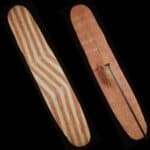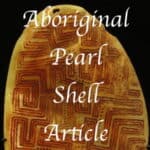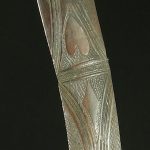Aboriginal Clubs
Aboriginal clubs come in many different forms depending on the region they come from. Different tribes made different styles of
There are several distinctive styles of Aboriginal Club from different Aboriginal tribes. In general, the value of an Aboriginal club will vary depending on its age, rarity, and design. Many of the very simple common clubs are not worth a great deal. The more interesting varieties and rare examples are collectible.
I buy Aboriginal Clubs and if you want to sell an aboriginal club then please feel free to send me some images. If you want to know what your club might be worth then contact me. I am always pleased to see tribal items.
How bent or flat a throwing club needs to be before it becomes a boomerang is a matter of opinion. Although many clubs used in warfare were also important in a ceremony. Some aboriginal clubs are ceremonial objects and not made with warfare in mind.
The most common and widely distributed of clubs would be better described as a throwing stick. They are usually about an inch in Diameter and 2-3 feet long. They have a resin handle at one end and are often fluted along the length. Due to
The following Aboriginal clubs are not an exhaustive list. It is a summary of the more exciting varieties of this unique art form.

I buy and sell Aboriginal Clubs
If you have one and want to know what it is worth.
Australia Aboriginal Club Types
South East Australia Aboriginal Clubs
Aboriginal Clubs Victoria
There is a whole variety of clubs from Victoria in South East Australia and they are all collectable.
The more unusual the design the better.
Ones with incised clan motifs and unusual shapes are the most collectable.
Broadly they can be divided into three categories.
a) Stabbing clubs which are long and thin with a pointed end
b) Sword clubs which are flattish in cross-section
c) Bulbous clubs for hitting and throwing
d) Leangle clubs made for hitting around a parrying shield. According to Aldo Massola in Aborigines of South Eastern Australia: ” These clubs were only used in fighting at close quarters. Blows aimed at the head only-to strike at any other part of the body considered being unfair tactics.”


Aboriginal Clubs
New South Wales
There is a whole variety of clubs from New South Wales in South East Australia and they are all collectable.
The more unusual the design the better.
Ones with incised clan motifs and unusual shapes are the most collectable.
Lil Lil Clubs come from Darling River region of New South Wales. They eliptical in cross section and shaped somewhat like a boomerang with a bulbous asymmetric end. Many are plain or chip carved but the most collectable ones have incised totemic designs. Thrown at the enemy they could be deadly. Flat in profile and are sometimes classified as a boomerang.
Bulbous head clubs. These are circular in cross-section with a bulbous head
Sword clubs have a boorang shaped top with a circular cross-section handle

Boomerang Fighting Clubs
Boomerang clubs are much to thick and heavy to be thrown. Some are even completely round in cross-section.
These clubs were used to settle disputes man on man and were held as shown opposite.
These boomerang clubs are usually over 100cm in length and are far to heavy to throw any distance and have no aerodynamic properties like boomerangs.
They are sometimes decorated with clan motifs but are often plain or have longitudinal grooving. They are very collectable.
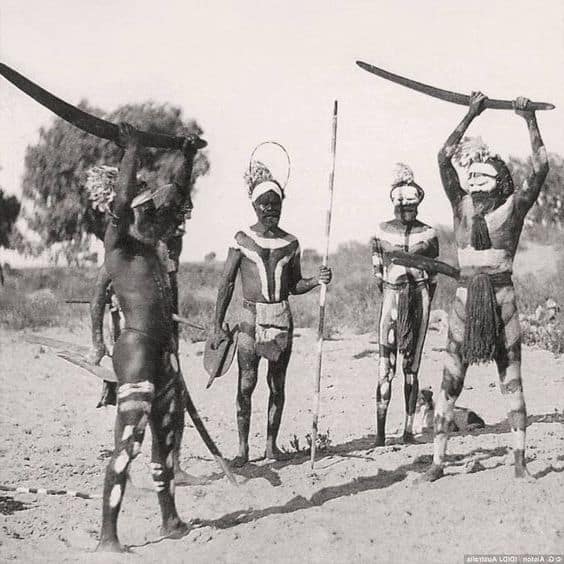

Queensland Aboriginal clubs
The majority of Queensland clubs are straight with a slight tapper. They are relatively common.
Another variety is the same shape but has wooden lugs protruding from the head. It is believed that these were inspired by stone-headed clubs traded down through the Torres Straits from New Guinea
As soon as nails became available, aboriginal people innovated and the nail-headed club became popular. The nails are usually those used by a farrier for fixing horse shoes.
Clubs depicted left range in size from 70cm – 125cm.
The large club on the right comes from Northern Queensland and is dicussed below.
Queensland Rain forest Aboriginal clubs
Often called sword clubs these are the largest clubs made in Aboriginal Australia.
They can be over 2 meters in length and are flat. They come from Far North Queensland and were used in a one on one formalized duals coupled with a Rainforest Shield.
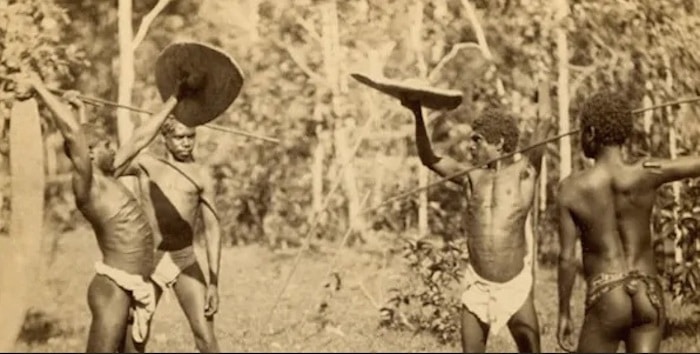

North Queensland Sword Club
Arnhem Land clubs
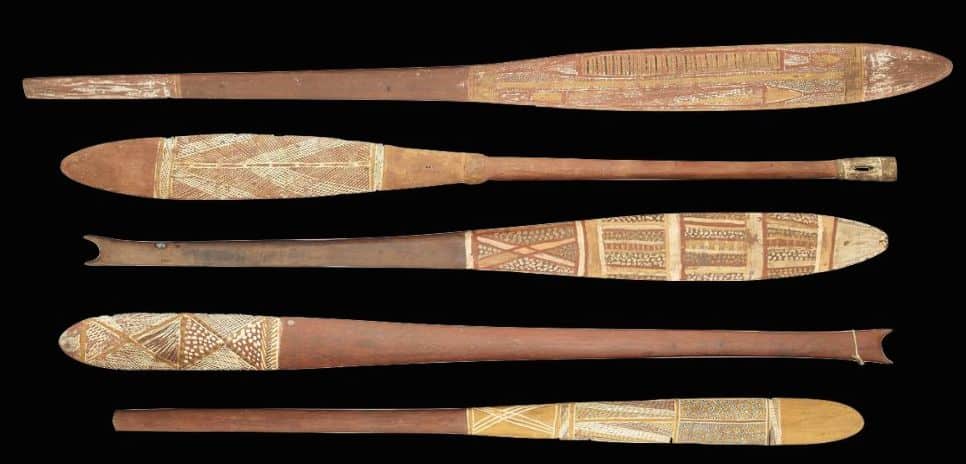
Not all aboriginal clubs from Arnhem Land have a distinctive fish tailed handle but the best ones often do.
They are finely painted on the upper third in clan motifs. Loss of this design detracts from their value.
They are flattish in profile and are a sword club. They are usually just over a meter long.
Tiwi Island Aboriginal Clubs
Aboriginal Clubs from the Tiwi islands were are either throwing clubs or ceremonial. The smaller throwing clubs are often unpainted or simply painted with a bulbous head and thin handle. Used in a manner like the Fijian Ula. Throwing clubs are collectible but it is the larger more beautifully painted ceremonial clubs that are more sort after. Large flat profile sword clubs from the Tiwi islands are less common.
Ceremonial Tiwi clubs are used in a similar fashion to the ceremonial spears that this region is famous for.
Sizes opposite range from 38 cm – 113cm

All images in this article are for educational purposes only.
This site may contain copyrighted material the use of which was not specified by the copyright owner.
Aboriginal Weapons and Artifacts
Other common names for aboriginal clubs
The Nulla Nulla is another name for an aboriginal club used for fighting and hunting. The word Nulla Nulla was first recorded in 1830–40.
A waddy is another term used for an aboriginal club. Waddy tend to be heavier and used for fighting.



